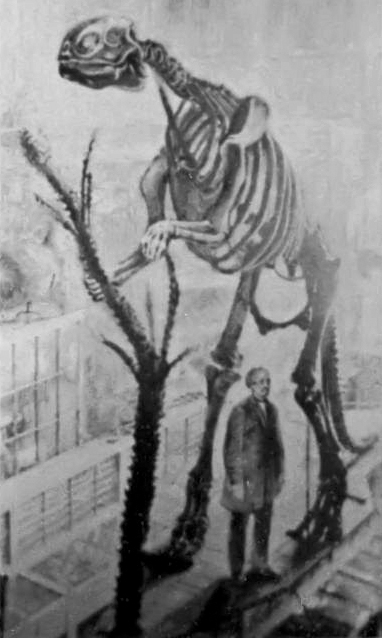 |
| Knight's Elotherium at AMNH |
It was in 1926 when Knight was asked to paint the 28 mural series that graces the walls of my beloved Field museum chronicling the history of life on Earth. Although the artist of many landscapes and prehistoric mammals, many of his pieces are famed for depicting Dinosaurs as active and fast-moving animals - many years ahead of this method of thinking among paleontologists. Knight's depictions were often based on basic biology, fossils and a lot of imagination, so some of his beasts turned out not to be entirely historically accurate. The accuracy of his 1897 depiction of Brontosauruses (Brontosauri?) was later debunked when Brontosaurus was found to have been land dwelling (Knight depicted the animals in water) and also not tail dragging. Considering the first complete dinosaur skeleton in the United States (Hadrosaurus Foulkii) had only been discovered in 1858, most of Knight's depictions were far ahead of his time.
 | ||
| One of those helpful informational plaques at | Field. |
Want to learn more? On the Field's multimedia site you can find a collection of all of their Knight pieces. You can also find a compilation of his work for the American Museum of Natural history here. Smithsonian's Dinosaur Tracker Blog has a great piece here about the more personal side of Knight's career and creativity by the excellent Brian Switek.
Although old-school paintings of dinosaurs might not seem as impressive as the CGI we have today, we have to remember that Knight was working in the later half of the 19th century and the beginning of the 20th. During this time, understanding of dinosaurs was limited, fossil hunting was still a bit like the wild west, and the true study of dinosaur behavior and habitat had barely begun. Knight's work was akin to a Ray Bradbury novel - exploring a far-flung locale, describing worlds in which no man had ever walked. The world of the dinosaurs was as foreign as the Martian landscape and the vision of Charles Knight helped bring this unbelievable world to life, and continues to do so for museum-goers today.
Source: http://www.charlesrknight.com/




